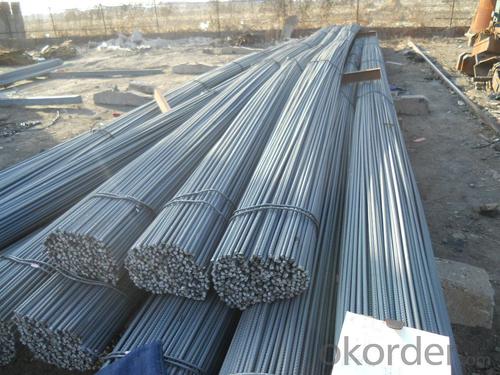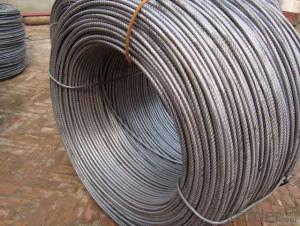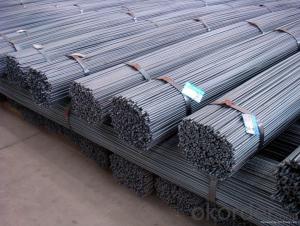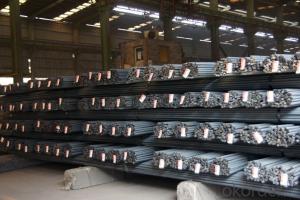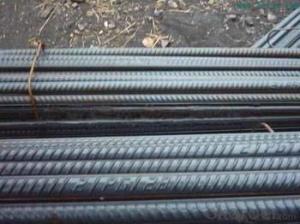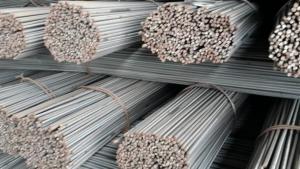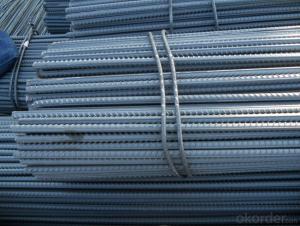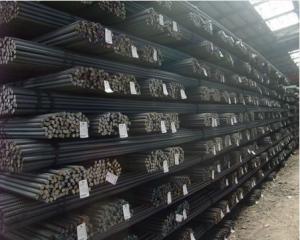HRB400 Deformed Steel Bar with high quality
- Loading Port:
- China Main Port
- Payment Terms:
- TT or LC
- Min Order Qty:
- -
- Supply Capability:
- -
OKorder Service Pledge
OKorder Financial Service
You Might Also Like
Product Description:
OKorder is offering HRB400 Deformed Steel Bar with high quality at great prices with worldwide shipping. Our supplier is a world-class manufacturer of steel, with our products utilized the world over. OKorder annually supplies products to European, North American and Asian markets. We provide quotations within 24 hours of receiving an inquiry and guarantee competitive prices.
Standard | GB | HRB400 | |
Diameter | 6mm,8mm,10mm,12mm,14mm,16mm,18mm,20mm, 22mm,25mm,28mm,32mm,36mm,40mm,50mm | ||
Length | 6M, 9M,12M or as required | ||
Place of origin | Hebei, China mainland | ||
Advantages | exact size, regular package, chemical and mechanical properties are stable. | ||
Type | Hot rolled deformed steel bar | ||
Brand name | CNBM | ||
Theoretical weight and section area of each diameter as below for your information:
Diameter(mm) | Section area (mm²) | Mass(kg/m) | Weight of 12m bar(kg) |
6 | 28.27 | 0.222 | 2.664 |
8 | 50.27 | 0.395 | 4.74 |
10 | 78.54 | 0.617 | 7.404 |
12 | 113.1 | 0.888 | 10.656 |
14 | 153.9 | 1.21 | 14.52 |
16 | 201.1 | 1.58 | 18.96 |
18 | 254.5 | 2.00 | 24 |
20 | 314.2 | 2.47 | 29.64 |
22 | 380.1 | 2.98 | 35.76 |
25 | 490.9 | 3.85 | 46.2 |
28 | 615.8 | 4.83 | 57.96 |
32 | 804.2 | 6.31 | 75.72 |
36 | 1018 | 7.99 | 98.88 |
40 | 1257 | 9.87 | 118.44 |
50 | 1964 | 15.42 | 185.04 |
Note:
1. Our products are produced according to national standard (GB), if not, supply according to national standards (GB) or agreement as customer required.
2. Other Grade and Standard Deformed Steel Bar we can supply:
Grade: GR40/GR60, G460B/B500A/B500B/B500C,BST500S
Standard: ASTM, BS, DIN
The Minimum Order Quantity of these products is high, and need to be confirmed.
3. We can not only supply Deformed Steel Bar; if you need anything about building materials, please contact us for further information.
4. Please send us your detail specifications when inquire. We will reply to you as soon as possible. We sincerely hope we can establish a long stable business relationship.
Product Applications:
HRB400 Deformed Steel Bar with high quality are ideal for structural applications and are widely used in the construction of buildings and bridges, and the manufacturing, petrochemical, and transportation industries.
Product Advantages:
OKorder's HRB400 Deformed Steel Bar with high quality are durable, strong, and resist corrosion.
Main Product Features:
· Premium quality
· Prompt delivery & seaworthy packing (30 days after receiving deposit)
· Corrosion resistance
· Can be recycled and reused
· Mill test certification
Product Specifications:
Standard: GB
Material: Q235
Origin place: China
Thickness: 3mm-30mm
Width:20mm-200mm
Length: Max 12m
FAQ:
Q1: What makes stainless steel stainless?
A1: Stainless steel must contain at least 10.5 % chromium. It is this element that reacts with the oxygen in the air to form a complex chrome-oxide surface layer that is invisible but strong enough to prevent further oxygen from "staining" (rusting) the surface. Higher levels of chromium and the addition of other alloying elements such as nickel and molybdenum enhance this surface layer and improve the corrosion resistance of the stainless material.
Q2: How do we guarantee the quality of our products?
A2: We have established an advanced quality management system which conducts strict quality tests at every step, from raw materials to the final product. At the same time, we provide extensive follow-up service assurances as required.
Q3: How soon can we receive the product after purchase?
A3: Within three days of placing an order, we will begin production. The specific shipping date is dependent upon international and government factors, but is typically 7 to 10 workdays.
bdenum enhance this surface layer and improve the corrosion resistance of the stainless material.
Images:
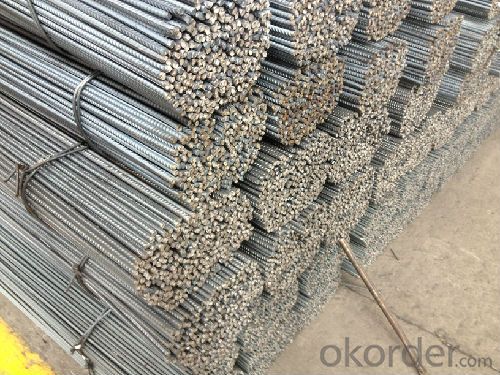
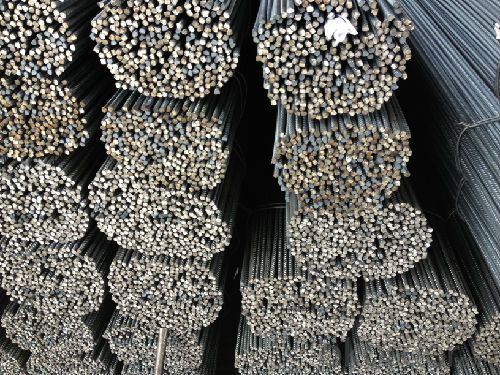
- Q: Can steel rebars be used in earthquake-prone regions?
- Yes, steel rebars can be used in earthquake-prone regions. Steel rebars are commonly used in the construction of reinforced concrete structures to enhance their strength and provide resistance against seismic forces. The flexibility and ductility of steel make it an ideal material for earthquake-resistant construction. Properly designed and installed steel rebars can improve the structural integrity and overall performance of buildings in earthquake-prone areas.
- Q: How do steel rebars impact the overall cost of a construction project?
- Steel rebars can have a significant impact on the overall cost of a construction project. Firstly, the cost of steel rebars themselves can be quite substantial, especially if large quantities are required. The prices of steel rebars are influenced by factors such as market demand, availability, and fluctuations in raw material prices. Moreover, the installation of steel rebars involves additional expenses such as labor, tools, and equipment. Skilled workers are needed to accurately place the rebars according to the construction plans, and this can increase the cost of labor. Additionally, specialized tools and equipment are required to cut, bend, and tie the rebars, adding to the project's expenses. The use of steel rebars also affects the construction timeline and subsequently impacts the project's cost. Construction projects often have strict deadlines, and any delay in the delivery or installation of rebars can result in additional expenses due to extended labor costs, idle equipment, and potential penalties for delayed completion. Furthermore, steel rebars play a crucial role in providing structural strength and durability to the building. By reinforcing concrete structures, steel rebars enhance their load-bearing capacity and resistance to various forces such as earthquakes and extreme weather conditions. This can reduce the risk of structural failures and the need for costly repairs or replacements in the future. In summary, steel rebars can significantly affect the overall cost of a construction project due to their initial purchase cost, installation expenses, impact on the construction timeline, and the long-term benefits they provide in terms of structural integrity and durability. Proper planning, procurement, and installation of steel rebars are essential to manage costs effectively and ensure the successful completion of the project within the allocated budget.
- Q: What is the effect of steel rebars on the formwork design?
- The formwork design in construction projects is significantly impacted by steel rebars. These reinforcement bars, also known as rebars, play a crucial role in providing strength and stability to concrete structures. One important aspect influenced by steel rebars in formwork design is the proper positioning and spacing of the rebars within the formwork. To ensure the structural integrity of the concrete element, the formwork must be designed to accommodate the rebars and allow for their correct placement. This may involve creating openings or recesses in the formwork to facilitate the passage of the rebars. The presence of steel rebars also affects the size and dimensions of the formwork. As the rebars occupy space within the concrete element, the formwork needs to be adjusted accordingly to accommodate these additional materials. This may require increasing the size or thickness of the formwork to provide the desired concrete cover over the rebars. Another factor influenced by steel rebars in formwork design is the consideration of the weight and load-bearing capacity of the formwork system. The addition of steel rebars significantly increases the weight of the concrete structure, necessitating the design of formwork that can withstand this additional load. This may involve using stronger and more durable materials for the formwork and ensuring proper bracing and support. Furthermore, the presence of steel rebars can impact the formwork construction process. The formwork design must carefully consider the installation and removal of the rebars without compromising the integrity of the formwork system. This may involve incorporating removable sections or panels in the formwork design to facilitate the placement and removal of the rebars. In conclusion, steel rebars have a profound impact on formwork design in construction projects. Proper consideration and planning are necessary to ensure the correct positioning, spacing, and support of rebars within the formwork. The presence of rebars also affects the size, dimensions, weight, and construction process of the formwork system. Overall, the successful construction of durable and structurally sound concrete elements relies on the proper integration of steel rebars within the formwork design.
- Q: What is the impact of steel rebars on the overall durability of a structure?
- Steel rebars have a significant impact on the overall durability of a structure. These reinforced bars enhance the strength and load-bearing capacity of concrete, making it more resistant to various forces such as tension, compression, and bending. By preventing cracking and improving structural stability, steel rebars greatly enhance the longevity and durability of a structure, ensuring it can withstand the test of time and various environmental conditions.
- Q: Are there any alternatives to steel rebars?
- There are multiple options available instead of steel rebars. One such option is the utilization of fiber-reinforced polymer (FRP) rebars, which consist of high-strength fibers embedded in a polymer matrix. FRP rebars present various advantages over traditional steel rebars, such as resistance to corrosion, high tensile strength, and lightweight characteristics. Moreover, they are non-magnetic and electrically non-conductive, making them appropriate for areas with concerns regarding electromagnetic interference. Another alternative is the employment of basalt rebars, which are manufactured from fibers derived from basalt rock. Basalt rebars offer similar benefits to FRP rebars, including corrosion resistance and high tensile strength. Furthermore, certain manufacturers have developed alternative materials like bamboo, carbon fiber, and glass fiber rebars, which have also displayed potential in specific applications. Nevertheless, it is crucial to consider that the selection of alternative rebars depends on the specific requirements of a project, and factors like cost, availability, and adherence to local building codes should be taken into account when choosing an alternative to steel rebars.
- Q: Can steel rebars be used in the construction of data centers and server rooms?
- Yes, steel rebars can be used in the construction of data centers and server rooms. Steel rebars provide structural reinforcement and can be used in the construction of walls, columns, and foundations. They help to enhance the overall strength and durability of the building, ensuring the safety and stability of the data center or server room infrastructure.
- Q: What are the common manufacturing processes for steel rebars?
- Steel rebars are manufactured through a series of steps to guarantee the production of durable and high-quality reinforcement bars. These steps usually consist of the following: 1. Melting: Initially, raw materials such as iron ore, coal, and limestone are melted in a blast furnace. This process yields molten iron, which is further refined to eliminate impurities. 2. Casting: Subsequently, the refined molten iron is poured into molds, creating large billets or blooms. These molds, commonly known as continuous casting machines, solidify the molten iron into a rectangular form. 3. Rolling: The solidified billets or blooms are then heated and passed through rolling mills. Through this rolling process, the steel is compressed between a series of rollers, reducing its thickness and shaping it into the desired dimensions of rebars. Additionally, this process enhances the mechanical properties of the steel while eliminating any internal defects or impurities. 4. Quenching and Tempering: Following the initial rolling, the rebars may undergo quenching and tempering. Quenching involves rapidly cooling the steel bars by immersing them in water or oil. This step increases the hardness of the rebars, making them more resistant to deformation and wear. Subsequently, tempering involves reheating the quenched bars to a specific temperature and gradually cooling them. This process eliminates internal stresses and improves the toughness of the rebars. 5. Cutting and Coiling: Once the rebars have been rolled and heat-treated, they are cut to the desired lengths using cutting machines. The cut rebars are then either coiled into bundles or stacked for storage and transportation. 6. Surface Treatment: Manufacturers often apply a protective coating or surface treatment to enhance the corrosion resistance of rebars. This can be achieved through hot-dip galvanizing, where the rebars are immersed in molten zinc to form a zinc coating, or epoxy coating, where a layer of epoxy resin is applied to the rebars. It is crucial to note that these manufacturing processes may vary depending on the specific requirements and standards set by different countries and industries. Nevertheless, the aforementioned steps provide a general overview of the common processes involved in manufacturing steel rebars.
- Q: Can steel rebars be used in pre-stressed or post-tensioned concrete structures?
- Yes, steel rebars can be used in both pre-stressed and post-tensioned concrete structures. In pre-stressed concrete, the rebars are tensioned before the concrete is poured, while in post-tensioned concrete, the rebars are tensioned after the concrete has hardened. The tensioned rebars help to improve the strength and durability of the concrete structures.
- Q: What is hot rolled coil? Hot rolled coil relative to thread steel and other steel, is not considered a higher point?
- Cold rolled strip is produced by pickling, rolling, annealing, finishing and oiling.Which requirements are higher for strip and thread steel, and because of the different products, the individual considers that there is no comparability.
- Q: How are steel rebars tested for quality and strength?
- Quality and strength of steel rebars are assessed through a series of standardized tests, ensuring adherence to required standards and ability to withstand anticipated loads and stresses. A primary test is the Tensile Test, which measures the maximum stress a rebar can endure before breaking. A sample rebar is pulled until it fractures, and the force needed to cause this fracture is measured. This test offers valuable data about the rebar's ultimate tensile strength, yield strength, and elongation. Another critical examination is the Bend Test, which evaluates the rebar's ductility and ability to resist breaking when bent. A sample rebar is bent to a specific angle, and any cracks or fractures are closely inspected. If there are no indications of failure, the rebar is considered acceptable. Furthermore, Chemical Analysis is performed to determine the rebar's chemical composition. This test ensures compliance with required chemical composition standards, as variations can impact the rebar's strength and durability. The Dimensional Test is conducted to verify that the rebar meets the specified standards in terms of dimensions, weight, and shape. Deviations from the required measurements can compromise the rebar's structural integrity. Additionally, the rebar's Surface Condition is visually evaluated to identify signs of rust, cracks, or other defects that could affect its performance. Proper surface condition is crucial for ensuring effective bonding with the surrounding concrete. Lastly, certain rebars undergo Non-Destructive Testing, such as ultrasonic testing or magnetic particle inspection, to identify hidden defects or cracks that may not be visible to the naked eye. In conclusion, these testing methods guarantee that steel rebars possess the necessary quality and strength for use in construction projects, providing essential reinforcement for reinforced concrete structures.
Send your message to us
HRB400 Deformed Steel Bar with high quality
- Loading Port:
- China Main Port
- Payment Terms:
- TT or LC
- Min Order Qty:
- -
- Supply Capability:
- -
OKorder Service Pledge
OKorder Financial Service
Similar products
Hot products
Hot Searches
Related keywords



